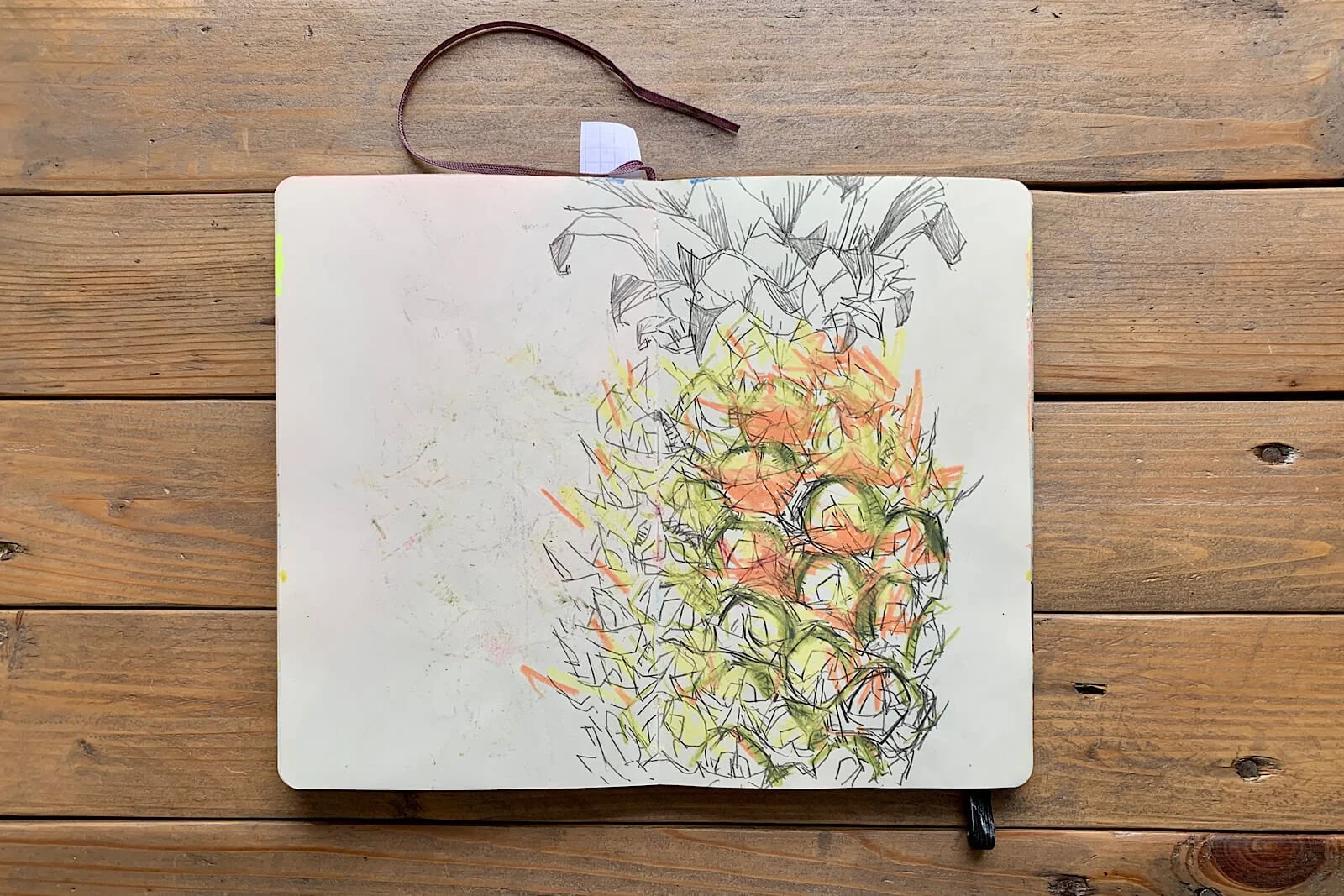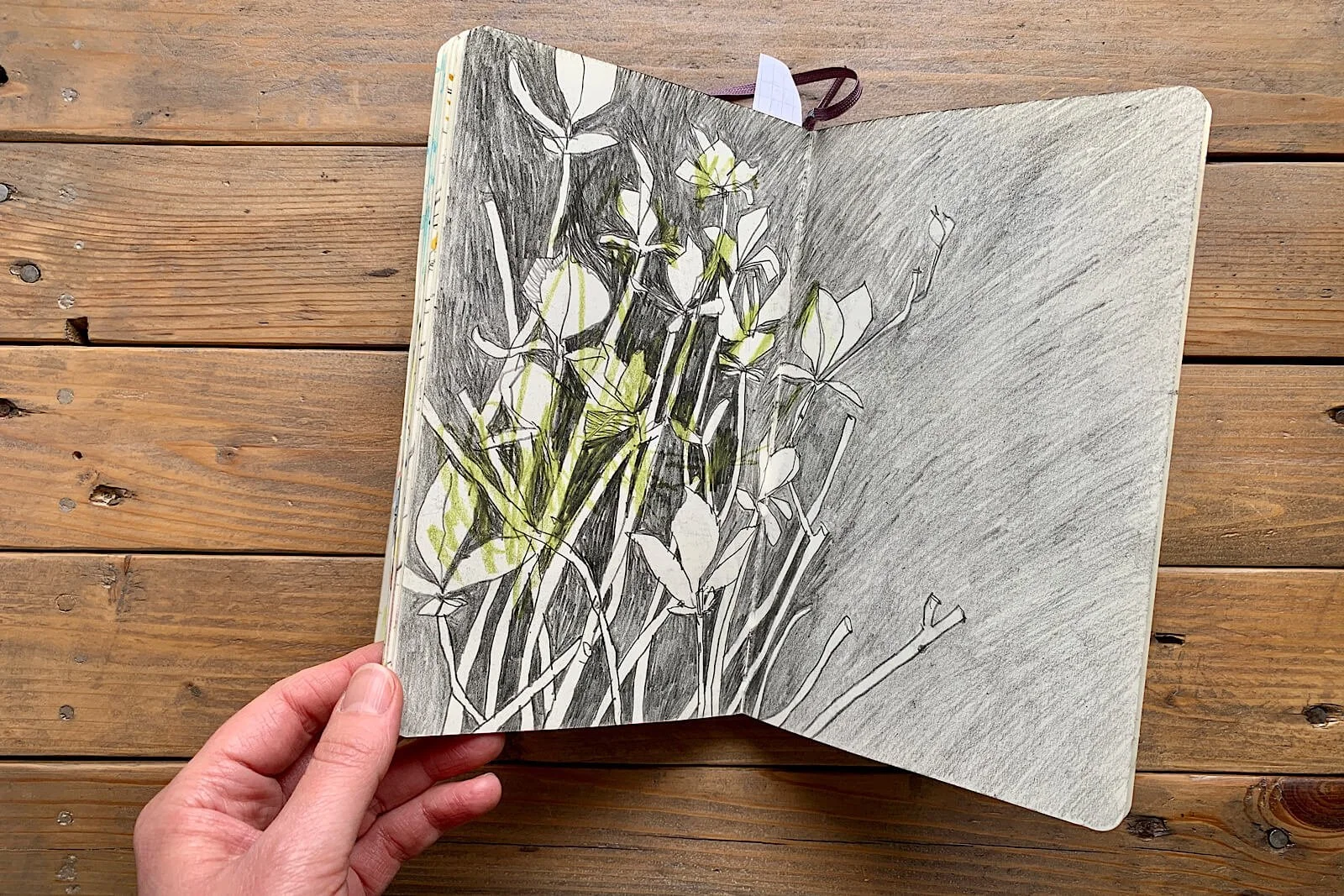Drawing in a sketchbook: Look to see so you understand the bigger picture and the details
Feel what you see
Taking a sketchbook for a walk outside is a marvellous way of recording details of the world around you. Jotting down observations and feeling the forms of a view through your fingertips, as the pencil moves across a page, gives a richer understanding of what you see. As a practicing fine artist this is why I’ve always got a couple of Moleskine’s on the go.
What’s a Moleskine?
Moleskine is a brand of sketchbook that’s known for its neat dimensions, hardback cover, elastic fastening strap and internal back pocket. Its pale parchment coloured paper has a silky smooth texture that takes pencil, ink and paint marks surprisingly well for a relatively thin page. In my opinion it’s one of the best sketchbooks of it’s kind and the handy A5 size makes it easy to carry around.
Marks matter
Because the quality of a mark matters to me I’m happy to pay the price for these little books. Pencils glide across the paper. Wet inktense leaves a pleasing stain. Highlighters and pastels work wonders and combinations of all of them are a delight. There’s just something so satisfying about the smoothness of the paper.
In some situations textured paper can be interesting to work with, particularly with watery mediums. However when it comes to drawing I think the results are more satisfying when you don’t have to fight with the paper. Drawing a pencil line on textured paper will always result in a bumpy line. I prefer to control the line myself. Like all things in life it’s each to their own, this just happens to be my favourite.
Drawing inspiration
More often than not my sketchbooks are full of drawings with no particular rhyme or reason to them. Most of my sketchbooking is done on holiday or at times when I’m away from the studio.
The books become a portable workplace and an opportunity to gather inspiration. I draw things that take my interest at that particular moment in time. Sometimes they are relevant to a current collection or perhaps they’ll become a place to start a new one (see the previous blog post about about how to create a new collection from one drawing).
Most of the time I see drawing in my sketchbook as a form of practice. Keeping my hand and eye coordination well exercised and my mind active. Some people enjoy doing a crossword, I prefer to draw. A lovely benefit of drawing is that you amass a visual diary full of ideas and lovely memories.
View overlooking Grasmere Lake from the 1st floor Games Room of Allan Bank National Trust. An hour well spent while my family played chess.
The bigger picture
These sketchbooks might be small but they are full of big ideas and even bigger landscapes. Out of the 14 sketchbooks I’ve filled since 2018, six of them have come the Lake District with me. The gentle rolling hills and drama of the lakes are an absolute delight to draw and call me back time and time again. I could write a whole blog post just about Grasmere… perhaps one day I will.
Delightful details
Sketchbooks are also a wonderful place to get lost in details. For me this usually revolves around flowers and plants. Their tiny universes invite you in for closer inspection of their delicate and complex structures.
Warm summer days are absolutely ideal for finding a shady spot in the garden and getting stuck into a big bunch of flowers. Tea and biscuits or a cool, crisp glass of wine offer a refreshing elixir and makes for a pleasant afternoon. I’d recommend this to a friend any day of the week.
Give it a try
In my experience the most successful sketchbook drawings are the ones made with a limited number of materials. This means you don’t get bogged down with what’s in your hands but rather spend the time considering what you’re looking at. The drawing will therefore become a suggestion of what you’re looking at rather than a copy (after all we’ve got phones in our pockets for that) and this is where the magic lies.
The unexpected marks and colours that come from working with what you’ve got rather than the control of being in a fully stocked studio. These random results can be even more pleasing when working on sketchbook pages already pre-marked with brush strokes left behind from another day. Rather than waste leftover paint I like to wipe my brush on a throwaway board. If one’s not to hand I’ll use a sketchbook, knowing I’ll come back to it another day and work over it. And when I say work, what I really mean is play.
Play time
There are very few professions I can think of where play time is a prerequisite for the job. Perhaps I’m being a little linear in my narrative as being able to brainstorm and think out side the box are valuable attributes for many career paths. I’m just not sure if there are many outside the creative realm that actively encourage people to practice playing. Play time is essential to an artist and helps unlock the untapped riches of heart and mind. Without play the work would be formulaic and probably lack personality.
The older I get the more I wish to remember the childhood freedom of standing in front of a blank page with a loaded paintbrush ready to go for it. My sketchbook are one of the few places in life I can feel like this. They are books just for me. The drawing can be of anything and nothing. They can be good, bad and all the stages in between. It doesn’t matter because no one else needs to see. They are spaces without limits or expectation, they are completely free.
Would you like to know more about the stories behind my art?
Sign up to BRIGHT News and be the first to know about new collections, work in progress and behind the scenes goings on in The Garage (my studio). I send a couple of short, upbeat emails a month that I do my best to fill with happy musings and curious ideas from my corner of the art world.
I Look forward to welcoming you.




























